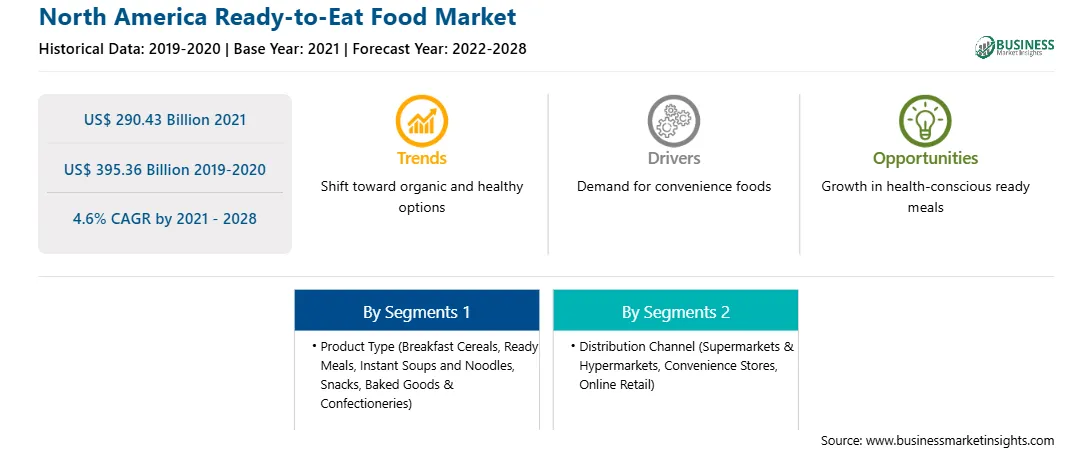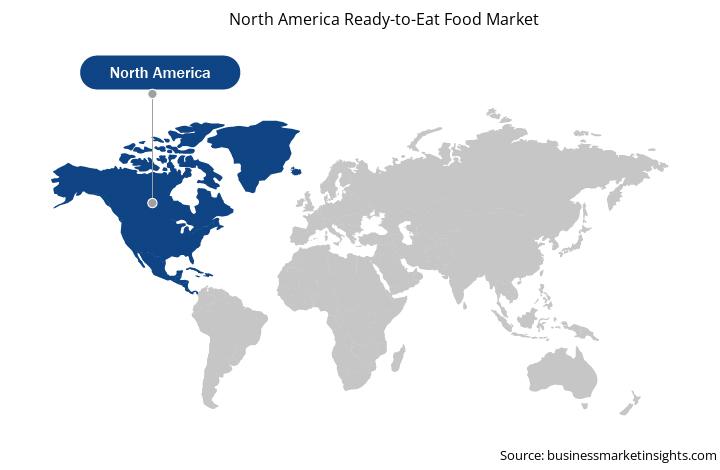The ready-to-eat food market in North America is expected to grow from US$ 290.43 billion in 2021 to US$ 395.36 billion by 2028. It is estimated to grow at a CAGR of 4.6% from 2021 to 2028.
The consumption of high-quality convenience food is increasing, which is currently one of the biggest trends in the food industry. Convenience food, such as ready-to-eat food, allows consumers to save time and efforts associated with ingredient shopping, meal preparation and cooking, consumption, and post-meal activities. The development of this food segment is ascribed to many social changes; the most notable of these include the increasing number of smaller households and the rising millennial population across the region. Due to hectic work schedules, millennials prefer to be efficient with their time rather than spending it on tedious tasks. Thus, they are more likely to spend their money on convenience in the near future, which drives the popularity of ready-to-eat food, such as baked products, snacks, and dairy products.
According to the data by Hartman Group, 96% of millennials replace a meal with a snack once a week, while 58% say they snack 4–5 times a day. 91% of all consumers say they eat snacks throughout the day, while 8% say they forget all meals entirely and just snack. These factors are contributing to a major shift among millennials toward daily snacking, replacing meals with savory and sweet snacks, in various formats. Convenience and taste are the main desired attributes among adults while buying food. According to the 2017 Food and Health Survey of the International Food Information Council (IFIC), convenience is a key driver for millennials when purchasing food, while taste is more important for baby boomers. As they get older and wealthier, millennials’ preferences shift toward more expensive eatables, such as customized healthy snacks, sugar-free confectioneries, and customized prepared meals.
Meal kit delivery companies, such as Blue Apron, and supermarket delivery services, such as Amazon Fresh and Instacart, have benefited from this preference for convenience and quality. Moreover, they find RTE food handling easy due to evolved cold supply chains. Millennials with no access to cars and not willing to waste time commuting to grocery stores, especially in urban areas, prefer online buying of RTE products. Thus, the demand for ready-to-eat food is surging with the increasing preference for convenience among millennials.
With new features and technologies, vendors can attract new customers and expand their footprints in emerging markets. This factor is likely to drive the North America ready-to-eat food market at a substantial CAGR during the forecast period.
Strategic insights for the North America Ready-to-Eat Food provides data-driven analysis of the industry landscape, including current trends, key players, and regional nuances. These insights offer actionable recommendations, enabling readers to differentiate themselves from competitors by identifying untapped segments or developing unique value propositions. Leveraging data analytics, these insights help industry players anticipate the market shifts, whether investors, manufacturers, or other stakeholders. A future-oriented perspective is essential, helping stakeholders anticipate market shifts and position themselves for long-term success in this dynamic region. Ultimately, effective strategic insights empower readers to make informed decisions that drive profitability and achieve their business objectives within the market.

| Report Attribute | Details |
|---|---|
| Market size in 2021 | US$ 290.43 Billion |
| Market Size by 2028 | US$ 395.36 Billion |
| Global CAGR (2021 - 2028) | 4.6% |
| Historical Data | 2019-2020 |
| Forecast period | 2022-2028 |
| Segments Covered |
By Product Type
|
| Regions and Countries Covered | North America
|
| Market leaders and key company profiles |
The geographic scope of the North America Ready-to-Eat Food refers to the specific areas in which a business operates and competes. Understanding local distinctions, such as diverse consumer preferences (e.g., demand for specific plug types or battery backup durations), varying economic conditions, and regulatory environments, is crucial for tailoring strategies to specific markets. Businesses can expand their reach by identifying underserved areas or adapting their offerings to meet local demands. A clear market focus allows for more effective resource allocation, targeted marketing campaigns, and better positioning against local competitors, ultimately driving growth in those targeted areas.

The North America ready-to-eat food market is segmented on the basis of product type, distribution channel, and country. Based on product type, the market is segmented into breakfast cereals, ready meals, instant soups and noodles, snacks, baked goods & confectioneries, and others. In 2021, the others segment held a larger market share, and the ready meal segment is expected to register a higher CAGR during the forecast period.
Based on distribution channel, the market is segmented into supermarkets & hypermarkets, convenience stores, online retail, and others. In 2021, the supermarkets & hypermarkets segment held the largest market share, and the online retail segment is expected to register the highest CAGR in the market during the forecast period.
Based on country, the market is segmented into the US, Canada, and Mexico. In 2021, the US held the largest market share, and Canada is expected to grow at the fastest CAGR during the forecast period.
Nestlé SA; Conagra Brands Inc.; The Kraft Heinz Company; General Mills Inc.; CAMPBELL SOUP COMPANY; MTR Foods Pvt Ltd.; Hormel Foods Corporation; Tyson Foods, Inc.; JBS SA; and The Kellogg Company are a few leading companies in the North America ready-to-eat food market.
The North America Ready-to-Eat Food Market is valued at US$ 290.43 Billion in 2021, it is projected to reach US$ 395.36 Billion by 2028.
As per our report North America Ready-to-Eat Food Market, the market size is valued at US$ 290.43 Billion in 2021, projecting it to reach US$ 395.36 Billion by 2028. This translates to a CAGR of approximately 4.6% during the forecast period.
The North America Ready-to-Eat Food Market report typically cover these key segments-
The historic period, base year, and forecast period can vary slightly depending on the specific market research report. However, for the North America Ready-to-Eat Food Market report:
The North America Ready-to-Eat Food Market is populated by several key players, each contributing to its growth and innovation. Some of the major players include:
The North America Ready-to-Eat Food Market report is valuable for diverse stakeholders, including:
Essentially, anyone involved in or considering involvement in the North America Ready-to-Eat Food Market value chain can benefit from the information contained in a comprehensive market report.